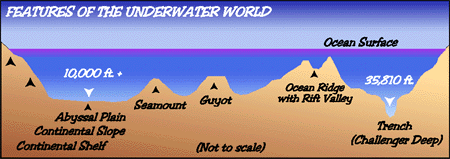The Ocean FloorThe deep-ocean floor has an average depth of 4000 meters (12,000 feet) with a significant variation in the depth. The ocean basins are cut by deep trenches and large mountains rise from the floor. The midocean ridge is the longest continuous chain of mountains on Earth winding its way along the sea floor through all the oceans. Its width average 1600 kilometers (1000 mi) with ridges rising an average of 1500 - 3000 meters ( 5,000 - 10,000 feet) above the floor. Along its spine, new sea floor is created and spreads apart by lava pouring out of rifts along the ocean ridge. Along the rugged volcanic topography of the ridge one finds dramatic undersea volcanoes called "black smokers". Long narrow arc-shaped trenches cut across the deepest parts of the ocean floor. Trenches are found near active plate margins where earthquakes and volcanoes are common. Converging plates in subduction zones recycle rock along the ocean trenches. Ocean-flooring drilling along trenches and the midocean ridge indicates that rock is recycled over a period of 2 to 3 million years. The deepest trenches are found along the Pacific "Ring of Fire". Trenches are common along curved island arcs like the Aleutian Islands. The vast submarine plains of the "ocean deep" are the abyssal plains. The abyssal plains cover 40% of the ocean floor with depths of 3000 - 6000 meters (10,000 - 20,000 ft). Wind deposition and volcanic eruptions have covered most in layers of brown and red clays. Some are covered with the remains of microscopic marine organisms known as ooze. The celebrated White Cliffs of Dover are uplifted ooze deposits. Rising from the ocean floor one finds seamounts, mountains that do not reach the water's surface and typically formed from extinct volcanoes. Guyouts are flat-topped seamounts.
Figure 2.19 Features of the ocean floor.
Continental MarginsThe continental margins are comprised of three topographic features. The ocean floor slopes gradually upward toward the continents forming the continental rise. Approaching the edge of the continent the slope of the ocean floor steepens into the continental slope. At the top of the slope lies the continental shelf, a gently sloping platform of varying width. Along passive margins like the east coast of the United States, the continental shelf is wide. The continental shelf is much narrower along active margins bordered by mountains like that found along the west coast of the United States.
Figure 2.20 Topography of continental margins Assess you basic understanding of the preceding material by "Looking Back: The Earth" or skip and continue reading. |


